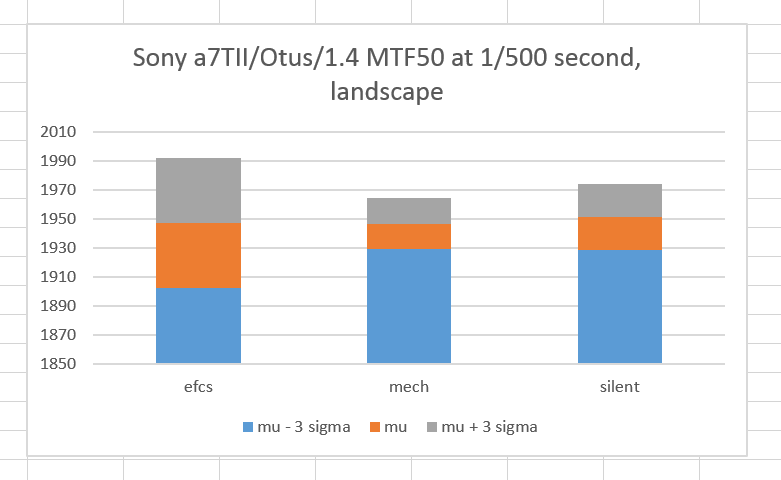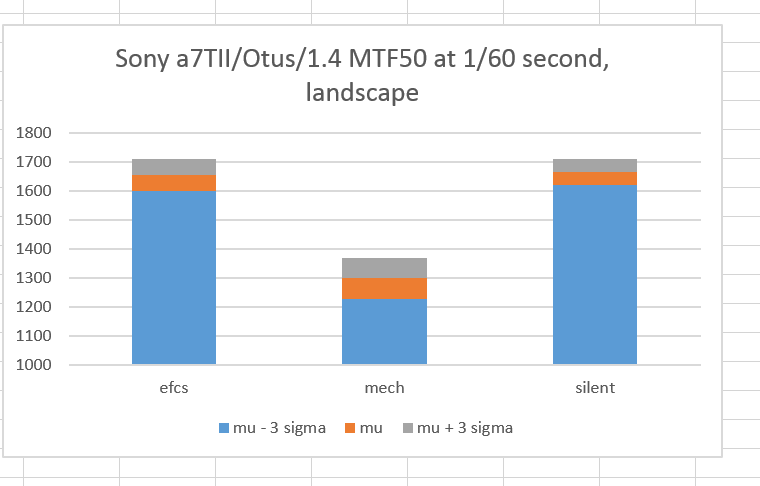The data in yesterday’s post was pretty noisy, but it seemed to indicate that somehow the silent shutter mode on the Sony alpha 7 R Mark II (a7RII) might produce images that were slightly less sharp than the electronic first curtain shutter (EFCS) mode. I foolishly speculated that the reduced bit depth of silent shutter mode might have something to do with it. I say foolishly because Horshack, on DPR, and Jack Hogan, in a comment on this blog, both pointed out an error in my thinking: at ISO 800, which I used for yesterday’s testing, the a7RII read noise would provide plenty of dither for an image with 12-bit precision.
The next step was to find out if the difference between EFCS and silent shutter was really there, or just a product of that sometimes wonderful and sometimes confounding human property of finding patterns whether they’re real or not.
Horshack helped be with the design of the experiment. In order to get the most sensitivity, we needed a sharp lens. I pulled out the sharpest one I have, the Zeiss Otus 85mm f/1.4 ZF.2. We wanted to minimize the read noise, which would provide dither. I set the ISO knob — well, virtual knob — to 100. We wanted a stable platform. I put the camera in landscape mode.
We wanted lots of images, for two reasons. First, so that we could compute the average results. Second, so that we could compute some statistics, and thus know if we’d used enough images. I picked 16 images per data point, which is a compromise between accuracy and avoiding terminal boredom on my part.
The protocol:
- The camera: the Sony a7RII.
- The lens: Zeiss Otus 85mm f/1.4 ZF.2
- No filter. I don’t have a variable ND filter big enough to fit the Otus 85.
- The lighting: a single Fotodiox LED-200WA-56 daylight balanced flood.
- ISO set to 100,
- Manual focusing wide open, then lens set to f/2.8
- Shutter set to 1/500.
- Drive set to single
- Self timer set to 5 seconds.
- Camera on an RRS TVC-43 with an Arca Swiss C1 head,
- RRS L bracket used for mounting the camera to the head.
- Make 16 exposures with the mechanical shutter
- Make 16 exposures with EFCS
- Make 16 exposures with silent shutter
- Set the lens to f/8 and the shutter to 1/60.
- Make another set of 48 exposures.
- Develop in Lightroom 5.7.1 with standard settings.
- Crop, export as TIFFs, analyze the horizontal edge. Measure MTF50 in Imatest .
- Export the results to Excel and graph.
The results for 1/500 second:
EFCS is on the left, the mechanical shutter is in the middle, and silent shutter is on the right. The blue bar goes to a value defined by the mean of all of the results less three standard deviations. The gray bar goes to a value defined by the mean of all of the results plus three standard deviations. If the distribution is Gaussian, only 3 out of 1000 values will lie outside that range.
The top of the orange bars represent the average values.
Note that the vertical axis, the units of which are cycles per picture height, are enlarged greatly so you can see the rather small differences.
Conclusion: silent shutter is no less sharp than EFCS.
Now, lets look at the 1/60 second results:
The first thing to notice is that, even with this very stable setup, the mechanical shutter results are much worse than the other two. Well, much worse when you’re graphing slanted edge MTF50 results. Most people would consider 1300 cycles/picture height to be a nice crisp image.
The second thing to see is that the EFCS and silent shutter results are virtually the same.
The third thing is that the MTF50 numbers are lower than at 1/500. This has nothing to do with shutter speed. The Otus isn’t nearly (again, “nearly” has to be understood in the context of a great lens tested under laboratory conditions) as sharp at f/8 as it is at f/2.8 (how many lenses can you say that about?).


Thanks (again) for the very useful article.
Have you found a way to assign EFSC to a “Custom Key Setting” or to the “Function Menu Set”?
> The second thing to see is that the EFCS and silent shutter results are virtually the same.
I infer you mean as far as “shutter shock” is concerned?
Is my understanding correct that “Silent Shutter” results in loss of bit-depth (12-bit), and there is a minor amount of “Shutter Lag” associated with “EFCS”?
And it remains to be seen if “Topic 172” about disabling EFCS with non E mount lenses is really valid or not. IIRC, you (or someone?) tentatively recommended turning EFSC [OFF] with shutter speeds of 1/1000s or faster.
I haven’t looked yet.
Yes, and for sharpness, too. The reduced bit depth does not affect sharpness, at least as measured wiht a slanted edge target.
I think this is completely bogus with dumb adapters.
My recommendation for max EFCS shutter speed is 1/2000 second. I will be doing some testing.
Jim
Thanks.
An aside: are you aware of anyone who does the kind of techno–geek experimenting/testing with Canon DSLR’s as you do with Sony and Nikon?
Sorry, no.
Jim,
You claim the otus 85mm “isn’t nearly as sharp” at f/2.8 as it is at f/8, but measuring it on the ImageMaster I found the differences in the center to be minimal, and the differences in the corners to hugely favor the stopped down numbers. You may view the results here: http://www.the-digital-picture.com/Reviews/MTF.aspx?Lens=957&FLI=0&API=2&LensComp=957&APIComp=5&CT=AVG
Did you refocus the otus between the f/2.8 and f/8 results? There is some small residual focus shift between the two apertures that may be significant enough to cause these differences.
Best regards,
Brandon
I think I said the opposite.
Sorry, I pulled a dyslexia. But that still doesn’t answer my question.
Just wanted to get things straight before replying. It’s late. I’ll post something tomorrow.
Jim
I’ve found that the most repeatable good results come from focusing that lens wide open. While focusing at the taking aperture may occasionally yield a better result, it does not on average, and the spread is worse, even with the Sony’s excellent focus peaking. The problem is that the threshold is not continuously adjustable.
In this particular test, the sharpness of the lens was not what was to be detirmined anyway.
In other testing, I have found f/4 to be the sharpest aperture in the center of the image with Otus 85.
I see. Thank you for your reply.
Hello, I sold my sony a7rII and the buyer send me a photo
with several dark bandings horizontal on an photo taken with
silent shutter, high iso 8000 and tungsten light.
Can you please explain that heavy mistake!
How can I send you that photo so you can imagine.
On this forum “Lebutler” told about the same problem.
http://www.sonyalphaforum.com/topic/1349-a7r-ii-silent-shooting/?p=8698
My guess is power line modulation of light level. But what do you care? You sold the camera.
Interesting; it couldn’t have been much more than a week old.
Jim
Hey Jim,
Are these findings valid for the A7RIII also?
and
what was the reason for suggesting that the max EFCS shutter speed is 1/2000?